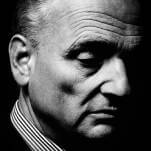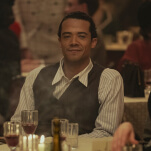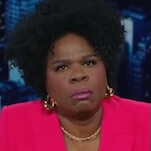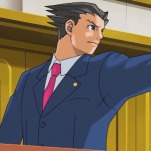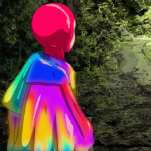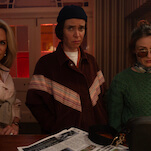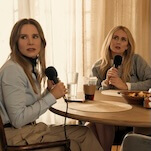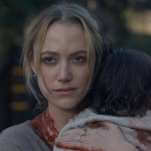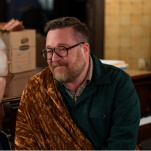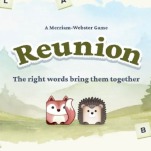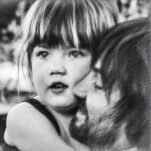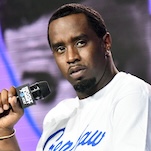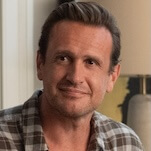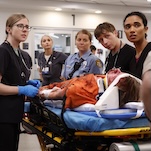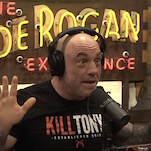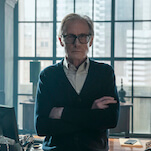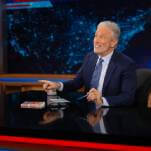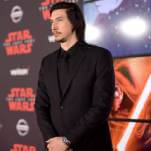Hindsight is 20/20. Does it get sharper when the distance between then and now is 20 years? The A.V. Club wasn’t putting together best-of lists in 1997, so it’s impossible to know how this retroactive ranking of the year’s movies might compare with one compiled by the staff at the time—especially since that staff has changed dramatically in the interim. So don’t think of the following hierarchy of great films (all released theatrically in America sometime in ’97) as a snapshot of how anyone, these writers included, felt back then. We’ve had two decades to mull 12 months of movies, to let them marinate in our imaginations, and to catch up with the sleepers we’ve missed. The years have been kind to the films below. To others, not so much. Remember when anyone thought As Good As It Gets was as good as it gets? We were so young once.
Robert Duvall spent years researching this true auteur project, which he wrote, directed, and starred in; when he couldn’t get a studio to make it, he found his own financing. Taking an unusually nuanced look at faith, redemption, and life in the American South, Duvall casts himself as Sonny, an evangelical preacher attempting to overcome his rocky past by building a church in rural Louisiana. Never blandly uplifting or smugly judgmental, The Apostle is clear-eyed about a region marred by poverty and racism but also graced with people genuinely trying to do their best. A stellar cast includes Farrah Fawcett as Sonny’s estranged wife, June Carter Cash as his mother, and Billy Bob Thornton as a local bigot (plus a performance by a young Walton Goggins). But it’s mostly a showcase for Duvall, who delivers a climactic sermon that’s one of the most electrifying pieces of screen acting ever filmed. [Noel Murray]
There are movies that require a strong stomach, and then there’s this documentary, in which a man hammers a nail through the head of his penis, for real, in close-up. Bob Flanagan, who died while Sick was being made, survived to age 41 despite having been born with cystic fibrosis—at the time, he was the oldest CF patient on record. It’s an agonizing disorder, which Flanagan chose to manage by finding means of exercising control over the pain he felt; eventually, he became a sort of performance artist, mixing black comedy and heartfelt confessionals with stunts to make even the most jaded viewer cringe. (If you’ve ever seen the uncensored video for Nine Inch Nails’ “Happiness In Slavery,” that’s him.) Sick isn’t an easy sit, for all sorts of reasons—toward the end, you’re literally watching the man die—but it’s as perversely life-affirming a movie as you’re ever likely to encounter. Imagine a Horatio Alger story in which Horatio can’t stop coughing and has a steel globe slightly larger than a pool ball shoved up his ass. [Mike D’Angelo]
What if John Cusack’s iconic Lloyd Dobler spent the decade after high school growing into a disillusioned contract killer? Technically, Grosse Pointe Blank isn’t actually an alternate-world sequel to Say Anything…, but it offers the most thoroughly Cusackian role since that 1989 classic. Martin Blank doesn’t have to sell anything bought or processed, but he’s starting to lose his murderous efficiency as he decides to attend his 10-year high school reunion and attempts to reconnect with Debi (Minnie Driver), the one who got away—or rather, the one he got away from without warning. There are a dozen ways this comedy could turn painfully shticky, but director George Armitage, working from a screenplay co-written by Cusack, keeps it crisp and wry, highlighting the Midwestern snap of supporting players Dan Aykroyd, Joan Cusack, and Jeremy Piven. Not even the only 10-years-after-high-school comedy released by Disney that April, Grosse Pointe Blank looks back in a rueful daze, like its central character wandering through the convenience store where his childhood home used to be. It recognizes how nostalgia can be both intoxicating and dangerous. [Jesse Hassenger]
David Cronenberg’s unsettling, moody adaptation of the J.G. Ballard cult classic novel of the same title casts a pitch-perfect James Spader as a TV producer who gets drawn into an underground subculture of car-crash fetishists after surviving a horrific head-on collision. Despite the NC-17 rating and hysterical, beyond-kinky subject matter, Crash ranks up there as one of the Canadian master’s most hypnotic exercises in pure style, its point of view established through disquieting sound design (the whoosh of traffic has never sounded so extraterrestrial), creepily clinical close-ups of seat-belt sashes, and eerily flat line deliveries—“a porno movie made by a computer” in the words of Roger Ebert, one of its most high-profile early defenders. Cronenberg’s movies develop tension through an internal conflict between the visceral and the clinical; this one tips all the way into the former, creating an alienating quasi-thriller that isn’t quite like any other movie around. [Ignatiy Vishnevetsky]
Kurt Russell gets an all-too-rare leading role in writer-director Jonathan Mostow’s wildly entertaining throwback thriller, playing an ordinary guy named Jeff who inadvertently becomes the target of interstate bandits. With terrific supporting performances by Kathleen Quinlan (as Jeff’s wife, who gets kidnapped by a seemingly helpful trucker after their car breaks down on a desolate stretch of road) and the always-reliable J.T. Walsh (as the casually cruel leader of a band of brigands), Breakdown is taut, lively, and only a little bit preposterous. It benefits greatly from the presence of Russell, who makes convincing both sides of the hero: the frantic family man stranded in the middle of nowhere among people who mean him harm; and the clever, crafty fellow who recovers his wits and satisfyingly outsmarts the bad guys. [Noel Murray]
Documentarian Errol Morris kicked off the ’90s by enduring long, difficult shoots on both his fiction feature debut, The Dark Wind, and his Stephen Hawking bio-doc, A Brief History Of Time. He then took some time to play around a bit, developing different ideas for new projects while fine-tuning an invention he called “the Interrotron” that allowed him to interview subjects more conversationally. His experimenting bore fruit with this one-of-a-kind documentary anthology, which weaves together the stories of four seemingly unrelated folks—a lion tamer, a hedge trimmer, a mole-rat researcher, and a robotics genius—into a larger meditation on how humanity struggles to bend nature to our will. Fast, Cheap & Out Of Control is a frequently funny and consistently fascinating film, but it also reflects the personal obsessions of an artist who spent the better part of a decade fighting to reclaim his creative freedom. [Noel Murray]
Ang Lee’s part-time job chronicling American history began with his first U.S.-set film, an unsparing but empathetic adaptation of Rick Moody’s novel about suburban Connecticut in 1973. The suburbs roiling with bad behavior and dirty secrets was a long-standing cliché well before The Ice Storm arrived on the scene, but Lee, Moody, and adapting screenwriter James Schamus observe every character in the pair of intertwined families with a clear, sharp vision of behavior that vacillates between soul-searching and self-destructive. The film’s effectiveness depends on its flawless ensemble, which catches a variety of talented actors at fascinating junctures in their careers: Kevin Kline doing his best middle-aged ennui (and clean-shaven, naturally), Christina Ricci and Elijah Wood on their way from child stardom to adolescent eccentricity, Joan Allen moving from character actor to lead, and Tobey Maguire just starting out, presciently narrating about a Fantastic Four comic. Forget the suburbs of the ’70s: Has any movie better captured the tensions and familiarity of Thanksgiving break? [Jesse Hassenger]
13. La Promesse
The Belgian brothers Jean-Pierre and Luc Dardenne had been making films since the late 1970s, but it was this low-budget drama that catapulted them out of obscurity—and with good reason. A morally troubled coming-of-age story set against the graying backdrop of the filmmakers’ hometown, Liège, La Promesse finds a guilt-ridden teenage boy (Jérémie Renier) being drawn into the life of the widow (Assita Ouedraogo) of an illegal immigrant whose death he helped cover up for his slumlord dad (Olivier Gourmet). Countless filmmakers have tried to imitate the Dardennes’ formula of hardened realism and pointedly mysterious character motivations since the duo ascended to arthouse superstardom as the kings of Cannes, but nothing compares to the real thing. Their documentary-trained eye for essentials informs every aspect of their breakthrough film, from the largely handheld Super 16mm camerawork to the performances of Renier and Gourmet, then-unknowns who have since gone on to successful careers. [Ignatiy Vishnevetsky]
With Happy Together, cinema’s poet laureate of heartache, Wong Kar-Wai, pinpointed a wrenching variation on his favorite theme, locating loneliness in companionship as well as solitude. Caught in a destructive cycle of breakups and reconciliations, two lovers (Leslie Cheung and Wong’s smoldering muse Tony Leung) leave Hong Kong for Argentina, hoping a fresh start in a new place will mend their broken relationship. Instead, the two fall back into old patterns, finding it difficult to live with or without each other. Wong’s matter-of-fact depiction of a queer romance was quietly radical in ’97, not to mention an implicit show of concern for what Britain’s impending handover of Hong Kong back to China would mean for the territory’s gay population. But Happy Together’s politics never eclipse its intoxicating style, as Wong drowns a grueling study of doomed amour in the nightlife incandescence of Buenos Aires. Wedged between the sublime breakup blues of Chungking Express and Fallen Angels and the exquisite will-they/won’t-they eroticism of In The Mood For Love, it’s the prickliest downer in a career full of them: a bad romance that hurts so good. [A.A. Dowd]
It’s probably fair to say that Neil LaBute didn’t quite live up to the promise of his first feature. But a thousand Wicker Man’s couldn’t dull the serrated edge of that debut, translated from stage to screen without an ounce of bilious insight lost. In a charismatically loathsome breakout performance, Aaron Eckhart plays clean-cut business bro Chad, who talks his less-confident superior, Howard (Matt Malloy), into a heartless scheme: As revenge on the opposite sex they feel has wronged them, the two will separately seduce and then simultaneously dump a shy, deaf co-worker (Stacy Edwards). More of a white-collar horror movie than the dark comedy it was billed as (though LaBute’s caustic dialogue has never been more unnervingly witty), In The Company Of Men is as paradoxically repellant and magnetic as Eckhart’s smiling human monster. Today it also looks nightmarishly prophetic, anticipating not just the cesspool of the MRA movement, but also a more insidious strain of toxic masculinity bubbling to its surface: For every dead-eyed, loud-and-proud misogynist like Chad, there’s an entitled “nice guy” like Howard, seething with resentment toward the women who don’t love him. [A.A. Dowd]
Released between Seven and Fight Club, which together cemented David Fincher’s reputation, The Game is often dismissed as comparatively minor—an amusing trifle predicated on a ludicrous plot device. No real-world outfit, it’s true, could match the omniscience of Consumer Recreation Services, which engineers an increasingly homicidal gauntlet for emotionally constipated billionaire Nicholas Van Orton (Michael Douglas) to run, ostensibly as a birthday present from his ne’er-do-well brother (Sean Penn). But who cares? The Game has a healthy sense of humor about its absurdity, which Fincher expertly indulges even as he cranks the clammy paranoia up to 11; it’s a film that tortures Van Orton in large part just because he’s the kind of guy who corrects others when they use “unsatisfied” instead of “dissatisfied.” There’s a big twist ending, but the real surprise, coming from a director who’d just served up America’s Future Sweetheart’s head in a box, is how earnest this tale of a wealthy asshole’s comeuppance turns out to be. [Mike D’Angelo]
The hip urbanite relationship gabfest to end all hip urbanite relationship gabfests, Arnaud Desplechin’s three-hour tour de force weaves together characters, social and personal anxieties, notes of stark drama, claustrophobic party scenes, and comic interludes with a deftness that, on some level, brings to mind another ambitious breakthrough film that hit American theaters in 1997: Boogie Nights. The difference is that Desplechin’s creative energy is essentially neurotic, his characters tightly wound, his camera squirrelly. As the French writer-director’s quasi-alter-ego, the rumpled graduate student Paul Dedalus, Mathieu Amalric leads a who’s-who cast of the era’s up-and-coming French actors, and the visual style is as diverse as the performances. (Unusually, it boasts three different directors of photography.) The movie’s formal and experimental range—which deploys theatrical direct-to-camera monologues, Ingmar Bergman-esque dream sequences, and gritty handheld camerawork with equal aplomb—recalls some of the era’s best postmodern fiction. If only every director who fictionalized their quarter-life crises felt like they had to work this hard to be understood. [Ignatiy Vishnevetsky]
Timeless premium pulp: the kind of expertly crafted grown-up entertainment that Hollywood only spits out every few years, if we’re lucky. The late Curtis Hanson tames one of James Ellroy’s labyrinthian crime novels into a fast-paced noir, sending an ensemble of variably scrupulous lawmen scrambling across a seedy, lavishly reproduced midcentury Los Angeles. The movie made a heavyweight out of its director, and stars out of its three central detectives; Russell Crowe, Guy Pearce, and Kevin Spacey each offer an officer fascinatingly flawed enough to headline his own crackerjack cop drama. Of course, L.A. Confidential holds up for more disturbing reasons, too; whereas contemporary reviews traced a straight line from the head-cracking racism of the film’s fictionalized 1950s LAPD to the vicious beating of Rodney King, viewers today will find no shortage of brand-new headline parallels to draw. Like a well-tailored suit, police brutality and corruption apparently never go out of vogue. [A.A. Dowd]
There’s something significant about the fact that The Sweet Hereafter neither begins nor ends with unspeakable tragedy. Instead, writer-director Atom Egoyan, an old pro at purposefully jumbling chronology, finds space in the middle for the school-bus crash that tears a small Canadian town asunder. Based on a 1991 novel by Russell Banks, this haunting, heart-wrenching drama was assembled with a sophisticated emotional logic; as an oddly Zen ambulance chaser, brilliantly played by Ian Holm, goes from family to family, attempting to unite the grieving parents into a class-action lawsuit, a vision of a community seized by traumas both public and concealed takes shape, one puzzle piece at a time. Egoyan’s movies would steeply decline in quality from here, so maybe it’s best to view his career out of order, too, with The Sweet Hereafter as its enduringly mysterious center. [A.A. Dowd]
When a movie makes billions worldwide or wins an Oscar for Best Picture, skepticism usually follows; when a movie does both, a backlash is giant-iceberg inevitable. But as unfashionable as it became in some circles when Titanic won the hearts of young women, the elderly, and the ocean, James Cameron’s romantic treatment of the doomed ocean liner remains a towering achievement, especially in the oft-disreputable field of disaster cinema. The writer-director’s canny talent for structure does wonders applied to a story where everyone knows the ending—and he marshals his vast budgetary resources with such showman confidence that a simple shot of a man hitting the doomed ship’s propeller as he plummets to the icy water has become strangely influential. A spectacular big-screen experience, the movie packs an emotional wallop, not just because of its details (the old couple embracing in bed as the water rushes around) and its charismatic performances (from Leonardo DiCaprio and especially Kate Winslet) but also because of the way Cameron shows Winslet’s (and Gloria Stuart’s) Rose pushing her way into the 20th century while keeping a passionate short-term love affair alive in her memory. [Jesse Hassenger]
One of the most merciless satires of its time, Paul Verhoeven’s gung-ho, bug-squashing Reich-fest confused critics and audiences when it hit theaters in 1997; from the gruesome effects and rousing battle scenes to the insidiously quotable script (“Would you like to know more?”) and darkly stirring score, it’s just too damn well-made for its own good. In the fascist 23rd century, young men and women don space-Stahlhelms and Gestapo leathers as they are shipped off to the distant planet Klendathu to be sacrificed to the military-industrial-media machine. Filled with violence, gratuitous nudity, and pretty young stars, the movie is as shameless as it is subversive, twisting sci-fi’s obsession with high-tech militaria into caricature, all the while rarely giving more than a wink as to its intentions. Starship Troopers is as close as we have to a parody of modern-day jingoism, and yet it still has the gall to be tremendously fun. [Ignatiy Vishnevetsky]
How strange would it have been to imagine, on the heels of Boogie Nights, that Paul Thomas Anderson would eventually turn into the elliptical celluloid mystic we know today? A porno-chic Goodfellas (just one of the many Martin Scorsese films quoted here), Anderson’s knowing, affectionate parody of the Great American Movie follows an ensemble of simple-minded dreamers—led by Mark Wahlberg’s heftily endowed busboy turned porn star Dirk Diggler—from the coked-up 1970s heyday of the porn film industry to its flaccid decline in the ’80s. Made with enough style to fill an entire textbook on film technique, the movie might have been suffocated by its own panache if it didn’t have the dramatic range to back up the technical razzle-dazzle: It’s uproariously funny, disturbingly sad, utterly engrossing, and boasts what might be the greatest supporting cast of the 1990s. [Ignatiy Vishnevetsky]
Olivier Assayas’ passion for cinema and his obsession with Hong Kong movie star Maggie Cheung (whom he’d marry a couple of years later) playfully intersect and collide in this unclassifiable experiment. Cheung plays herself, puzzled but game, as she tackles the lead role in a remake of the silent serial Les Vampires. Assayas orchestrates a giddy whirlwind around her: an aging auteur (Jean-Pierre Léaud) whose instructions in broken English (since Cheung speaks no French) are beyond cryptic; an outspoken costume designer (Nathalie Richard) with an unrequited crush on her leading lady; a random hotel guest (Arsinée Khanjian) whose room Cheung impulsively burgles while still dressed in her character’s skintight latex catsuit. (Les Vampires’ so-called vampires are sneak thieves, not literal bloodsuckers.) The chaos and delirium build to a spectacular avant-garde ending that feels like it’s burying and reinventing the medium simultaneously. It’s as if Assayas made this movie as an open letter to himself, asking why he feels driven to make this movie. His failure to arrive at anything like a coherent answer is more invigorating fun than one could imagine. [Mike D’Angelo]
Yes, really. John Woo’s extravagantly ridiculous Hollywood shoot-’em-up doesn’t transcend the absurdity of its premise—it elevates it to some staggering new peak of operatic melodrama. Taking his obsession with adversaries as brothers to its illogical end point, the Hong Kong maestro of ultraviolence casts John Travolta and Nicolas Cage, then two of America’s biggest movie stars (as well as recent Oscar royalty), as mortal enemies on opposite sides of the law who literally swap visages and assume each other’s identities. The gunfights are pageants of balletic excess, but that’s to be expected from the director of Hard Boiled and The Killer. The true warped genius of Face/Off lies in the high-concept (over)acting showcase it affords its headliners, who don’t just ravenously compete to chew the most scenery—they also mimic each other’s over-the-top performances. It’s one of the funniest, nuttiest, most psychologically thrilling action movies ever bankrolled by a major studio. So what if it makes not a damn lick of sense. [A.A. Dowd]
“It’s not Pulp Fiction.” That, in so many words, was a fairly common complaint lodged against the third film by Quentin Tarantino, which hit theaters on Christmas Day 1997 and promptly failed to feature a single gimp, Big Kahuna Burger, or dance contest at Jack Rabbit Slim’s. But Jackie Brown has aged like fine wine. Working for the first and so-far only time with material he didn’t concoct in his own reference-stuffed, film-geek cranium, Tarantino deepens Elmore Leonard’s Rum Punch into a thing of loquacious beauty, a crime drama at once tense and relaxed. All of Tarantino’s gifts are on full display, from his ear for hilariously digressive dialogue to his way with a perfectly selected jukebox staple to his ability to coax electrifying performances out of an all-star cast. (Is this the last great turn by Robert De Niro?) But more so than anything QT has made before and anything he’s done since, Jackie Brown believes in its characters—not as emblems of genre cool, but as flesh-and-blood people. And when he makes room for a bona fide love story between Pam Grier’s whip-smart heroine and Robert Forster’s wearied bail bondsman, it’s more than a clever game of 1970s-cinema-icon bingo; we’re seeing a remarkably soulful middle-age romance tucked into the folds of a byzantine caper. No, Jackie Brown isn’t Pulp Fiction. It might actually be better. [A.A. Dowd]

